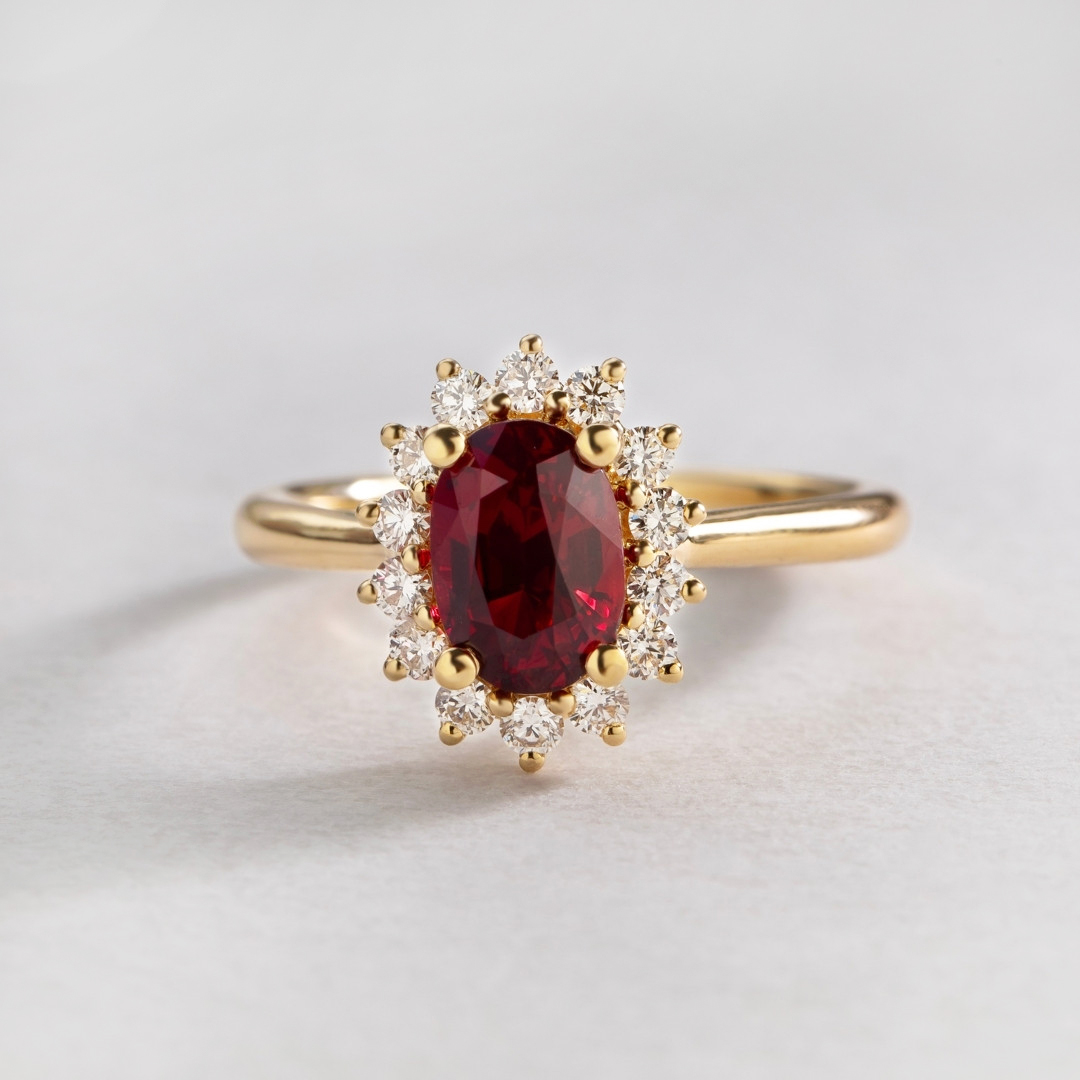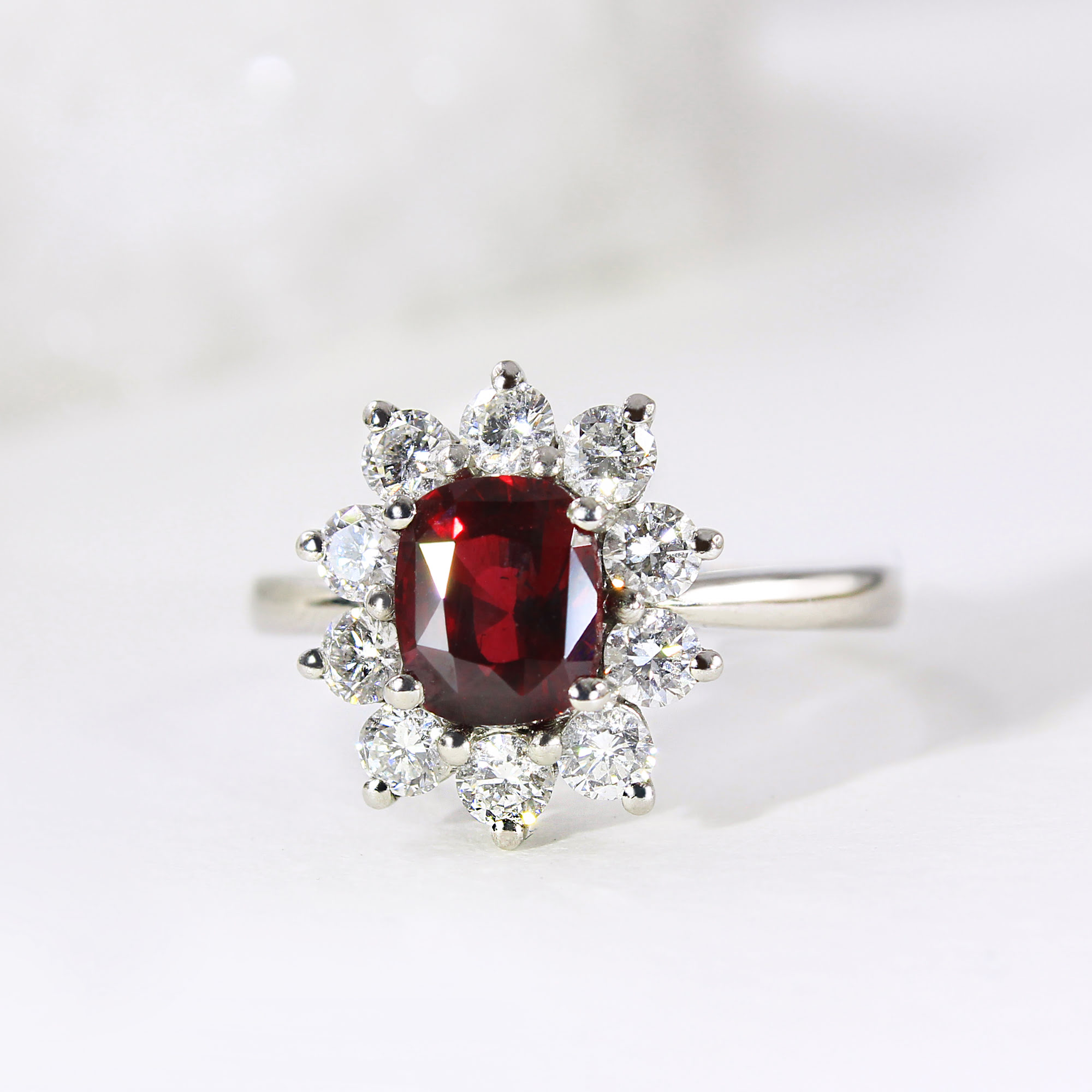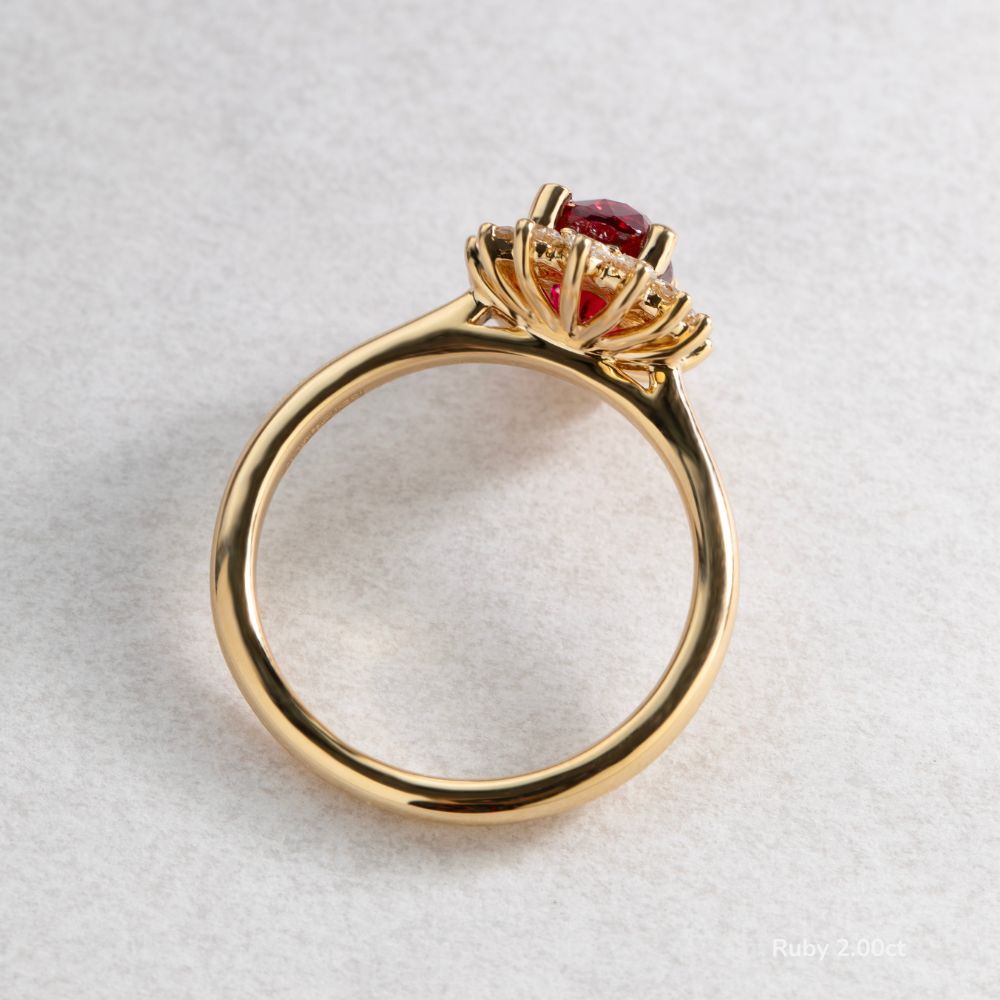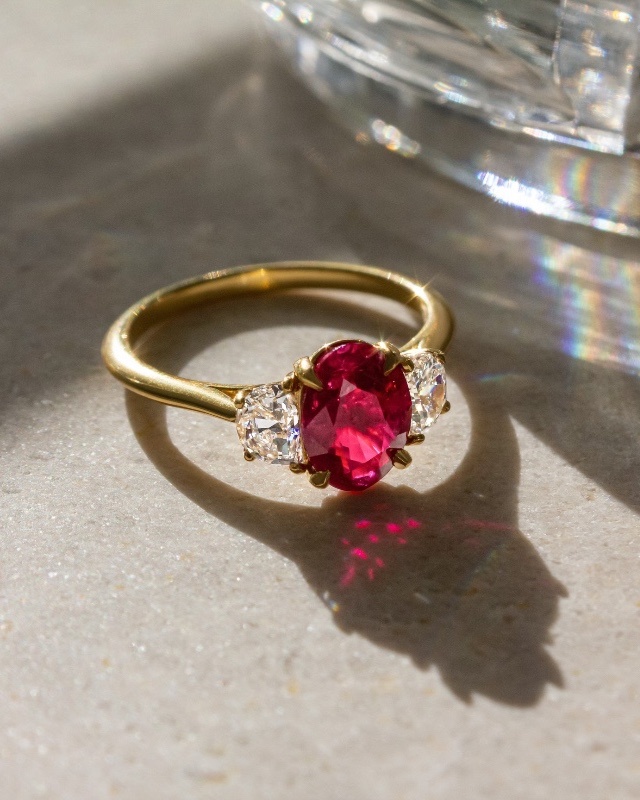
23 Feb 2025 — by Flawless Fine Jewellery — Reading time 12 minutes
Ruby Gemstones 101: From History to Buying Tips
The Knowledge You Need To Find Your Perfect Gemstone
Introduction
Rubies are one of the most sought-after gemstones, renowned for their vibrant red colour and rich history. Known as the “King of Gems,” rubies symbolise power, passion, and wealth. This guide on Ruby gemstones will explore everything you need to know about rubies, from their fascinating origins to the key factors influencing their value, such as the 4 Cs—colour, clarity, cut, and carat weight.
We’ll also cover how to distinguish natural rubies from synthetic ones, tips for selecting the perfect ruby for jewellery, and advice on caring for your gemstone. By the end of this guide, you’ll have a deeper understanding of rubies, whether you’re a jewellery enthusiast or looking to purchase one.

History and Mythology of Rubies
Rubies have been treasured for centuries, not only for their striking beauty but also for their rich symbolism and cultural significance.
Early Use and Significance
Ancient Civilisations: Rubies were highly valued by ancient cultures, such as the Burmese, who believed they granted invincibility in battle, and Indian royalty, who saw them as symbols of wealth and protection.
Indian and Burmese Traditions: In India, rubies were considered the “King of Gems,” believed to bring prosperity and health. The Burmese believed embedding rubies in the flesh would make soldiers invincible.
Mythological Symbolism
Love and Passion: Rubies have long been associated with love, vitality, and passion. Ancient Greeks and Romans viewed them as representing the heart’s blood.
Buddhist Beliefs: In Buddhism, rubies are considered one of the “seven treasures,” symbolising good fortune and spiritual enlightenment.
European History
Medieval and Renaissance Europe: Rubies were worn by royalty as symbols of power and protection, often believed to safeguard against evil spirits.
Crown Jewels: Rubies still feature in royal collections, like the British Crown Jewels, symbolising strength and wealth.
Modern-Day Symbolism
Today, rubies continue to represent love and vitality, often gifted to mark important milestones like anniversaries.

Ruby Formation and Geological Facts
Rubies are a variety of corundum, formed under extreme heat and pressure deep within the Earth. Their formation process and geological locations contribute to their unique qualities.
Formation Process
Mineral Composition: Rubies are primarily made of aluminium oxide (Al₂O₃) with trace amounts of chromium (Cr), which gives them their red colour.
Extreme Conditions: They form under high heat and pressure, typically at depths of 18 to 30 miles below the Earth’s surface, in metamorphic rocks like marble or igneous rocks like basalt.
Key Locations
Myanmar (Burma): Famous for high-quality rubies, particularly known for the “Burmese” deep red hue.
Thailand: Known for heat-treated rubies, especially from the Chanthaburi region.
Sri Lanka: Produces rubies ranging from light pink to deep red.
Mozambique: A rising source of vibrant, high-quality rubies.
Unique Features
Star Rubies: Some rubies display a star pattern due to rutile inclusions, making them highly valued.
Inclusions: Natural inclusions, while sometimes considered flaws, can also enhance a ruby’s character and reveal its origin.
The 4 Cs of Rubies
The value of a ruby is determined by four key factors: Colour, Clarity, Cut, and Carat weight.
1. Colour
Most Important: The best rubies have a vibrant “pigeon blood” red colour. The richer and more saturated the red, the more valuable the ruby.
Hue and Tone: Rubies range from pinkish-red to purplish-red, but the brightest red is the most desirable.
2. Clarity
Natural Inclusions: Rubies often have inclusions, which can affect their transparency. Fewer visible inclusions mean higher value.
Star Effect: Rutile inclusions can create a star-like effect in cabochon-cut rubies, adding value in some cases.
3. Cut
Shape and Symmetry: A well-cut ruby should enhance its colour and clarity. Popular cuts include oval, cushion, and round.
Proportions: Proper proportions ensure brilliance and maximise the stone’s appearance.
4. Carat Weight
Size vs. Value: Larger rubies are rarer and more expensive, but size alone doesn’t determine value. A smaller ruby with better colour and clarity can be more valuable.
Price: As carat weight increases, so does the price, especially for high-quality rubies.
Famous Rubies
Several rubies throughout history have gained fame for their size, quality, or historical significance. Here are a few of the most renowned:
1. The Red Emperor Ruby
Origin: Myanmar (Burma)
Size: 15.99 carats
Significance: Known for its rich “pigeon blood” red colour, this ruby is one of the finest ever discovered. It was sold at auction for a record price, highlighting its exceptional quality.
2. The Star of Burma
Origin: Myanmar
Size: 6.04 carats
Significance: This ruby is renowned for its deep red colour and unique star-shaped asterism, caused by rutile inclusions. It is one of the most famous star rubies in the world.
3. The Hope Ruby
Origin: Myanmar
Size: 32.08 carats
Significance: Part of the famous Hope collection, this ruby is known for its flawless clarity and intense red hue. It has been part of several prestigious collections over the years.
4. The The Burmese Ruby Necklace
Origin: Myanmar
Significance: This necklace, featuring multiple rubies set in diamonds, was a gift to the Queen of England in 1973. It features rubies of exceptional quality and is part of the British royal collection.
5. The The “Black Prince’s Ruby”
Origin: Myanmar
Size: 170 carats
Significance: Despite its name, this is actually a large red spinel, often mistaken for a ruby. It has been part of the British Crown Jewels since the 14th century.

Types of Ruby Cuts
The cut of a ruby is crucial in enhancing its beauty, as it affects how light interacts with the gemstone. Below are the most common types of ruby cuts:
1. Round Cut
Popularity: The most classic and popular cut for rubies.
Appearance: Offers maximum brilliance and light reflection.
Use: Common in engagement rings and fine jewellery.
2. Oval Cut
Shape: Elongated round shape with soft curves.
Appearance: Known for its flattering effect on the finger or neckline, giving a larger appearance than a round cut of the same carat weight.
3. Cushion Cut
Shape: A square or rectangular shape with rounded corners, resembling a pillow.
Appearance: Soft and vintage-looking, often used for larger rubies to highlight their colour and clarity.
4. Emerald Cut
Shape: Rectangular with stepped facets.
Appearance: Known for its elegant, sophisticated look. The cut highlights the clarity of the ruby, making it ideal for high-quality stones.
5. Pear Cut
Shape: Teardrop-shaped with a rounded end and pointed tip.
Appearance: Offers a unique, asymmetrical look, often used in pendants and earrings.
6. Marquise Cut
Shape: Elongated oval shape with pointed ends.
Appearance: Maximises the surface area of the ruby, creating a dramatic, bold look. Ideal for larger rubies.
7. Cabochon Cut
Shape: Smooth, rounded shape with no facets.
Appearance: Often used for rubies with star-like inclusions, as it enhances the star effect and gives a more opaque, polished look.
Synthetic Rubies vs. Natural Rubies
Understanding the difference between synthetic and natural rubies is key when buying one.
1. Natural Rubies
Formation: Created naturally over millions of years under heat and pressure.
Value: Rarer and more expensive due to their unique formation and inclusions.
2. Synthetic Rubies
Creation: Lab-grown using processes that mimic natural conditions.
Value: More affordable, with fewer inclusions and larger availability.
3. Key Differences
Price: Natural rubies are more costly, while synthetic rubies are less expensive.
Inclusions: Natural rubies have unique inclusions; synthetic rubies typically have fewer or different inclusions.
Certification: Always check certificates to verify authenticity.

Ruby in Jewellery
Rubies are a popular choice for jewellery due to their vibrant colour, durability, and timeless appeal.
1. Engagement Rings
Symbolism: Rubies symbolise love, passion, and commitment, making them a popular alternative to diamonds for engagement rings.
Setting Options: Often set in classic solitaires, halo settings, or alongside diamonds for added brilliance.
2. Necklaces and Pendants
Statement Pieces: Rubies are often featured in necklaces or pendants, adding a pop of colour to formal or everyday attire.
Custom Designs: Can be set in a variety of styles, from simple designs to intricate, vintage-inspired settings.
3. Earrings
Versatility: Ruby earrings, whether stud or drop, can be worn for both casual and special occasions.
Pairing: Rubies are often paired with diamonds or other gemstones for a more dynamic look.
4. Bracelets and Rings
Bold and Elegant: Rubies in bracelets and rings make for stunning statement pieces, either as the centrepiece or alongside other stones.
Custom Settings: Popular in custom designs and often used in cocktail rings or tennis bracelets.
5. Durability
Hardness: As one of the hardest gemstones (9 on the Mohs scale), rubies are highly durable, making them suitable for everyday wear.
Care and Maintenance of Ruby Jewellery
Rubies are durable, but proper care helps preserve their beauty.
1. Cleaning
Gentle Method: Clean with warm soapy water and a soft cloth.
Avoid Harsh Chemicals: Never use strong cleaners or ultrasonic devices.
2. Storage
Separate Storage: Keep rubies in a soft pouch or box to prevent scratches.
Avoid Heat: Keep rubies away from direct heat and sunlight.
3. Protection
Avoid Impact: Don’t wear rubies during physical activities to prevent damage.
Regular Checks: Inspect the setting for loose stones or damage.
4. Professional Care
Annual Servicing: Have your ruby jewellery professionally cleaned and checked.
The Investment Value of Rubies
Rubies are valuable investments due to their rarity and enduring demand.
1. Rarity and Demand
Limited Supply: High-quality rubies, especially “pigeon blood” ones, are rare and highly sought after.
Increasing Popularity: Growing demand for coloured gemstones boosts ruby value.
2. Long-Term Value
Appreciation: Rubies often increase in value over time, particularly the finest specimens.
Historical Appeal: Their connection to royalty and collectors adds to their investment potential.
3. Market Trends
Strong Auction Prices: Rubies have reached record prices at auctions, indicating solid investment potential.
Stable Investment: Rubies retain value over time, unlike more volatile assets.

Pricing of Ruby Gemstones
Ruby prices depend on colour, size, clarity, and origin.
1. Colour
Highest Value: “Pigeon blood” red rubies are the most expensive.
Lighter Shades: Pinkish or purplish rubies are more affordable.
2. Size and Carat Weight
Larger Stones: Rubies over 1 carat increase in price, especially over 5 carats.
3. Clarity
Clear Rubies: Stones with fewer inclusions are valued higher.
4. Origin
Premium Locations: Rubies from Myanmar and Sri Lanka command higher prices.
5. Price Range
Affordable: £200–£1,000 per carat (smaller/lower quality).
Mid-Range: £1,500–£5,000 per carat (high quality).
Premium: £10,000–£20,000+ per carat (exceptional quality).tyles.
FAQ’s
1. What is the best colour for a ruby?
The ideal ruby colour is a vibrant “pigeon blood” red. Rubies with a rich, pure red hue are the most valuable.
2. Are rubies more expensive than diamonds?
Generally, rubies can be more expensive than diamonds, especially those with exceptional colour and size. However, diamonds are more commonly available, which can affect pricing.
3. How can I tell if my ruby is real?
To verify authenticity, look for inclusions under magnification (natural rubies typically have some). A gemologist can also provide a certificate of authenticity.
4. What are synthetic rubies?
Synthetic rubies are lab-grown gemstones that replicate the appearance of natural rubies. They are generally more affordable but have the same physical properties.
5. How do I care for ruby jewellery?
Clean rubies with warm soapy water and a soft cloth. Store them separately from other jewellery to avoid scratches and have them professionally inspected annually.
6. Can rubies be worn every day?
Yes, rubies are durable and rated 9 on the Mohs hardness scale, making them suitable for daily wear. However, it’s best to avoid rough activities that could cause damage.
7. What makes rubies so valuable?
Rubies are valued for their rarity, vibrant colour, and durability. The finest rubies, especially those with “pigeon blood” red, can command high prices due to their scarcity.
